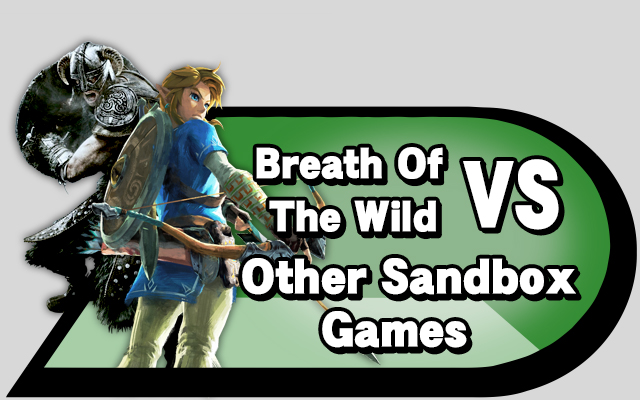Breath of the Wild. You’re either citing it as a crown jewel in the franchise and one of the best games ever made, or making a negative opinion about it just to try and lower the user score on Metacritic.

It’s popular, so it sucks. Classic internet motto.
A little over three weeks after release, the general opinion of most people is that Breath is a great title. I myself have yet to finish it, having only recently acquired a Switch, but so far, I find myself enjoying it, even as someone not into Zelda. Though that likely has a reason; Breath has taken an unorthodox route for the franchise and made itself an open world RPG-esque game, following in the footsteps of some past generation games like Skyrim, Metal Gear Solid 5: The Phantom Pain, and Dark Souls. So let’s have a look at how it implements some of the better known mechanics from some of these titles.
For veterans of these titles, the comparisons begin once you start up the game for the first time. You begin in a small, enclosed area which runs you through some basics before dropping you into the open world, not unlike an Elder Scrolls or Fallout. Unlike some of its contemporaries, however, Breath is much quicker in dropping you out, technically. All you have to hear is some dialogue, do some running and jumping, and you’re free to either explore or get to the main story immediately, the latter option also happening quickly for most players.

He said I was his friend, which came as some surprise.
In Breath’s case, following the story is actually a good idea for the time being to ease exploration, which brings to mind a different open world from Nintendo: Xenoblade Chronicles X. Exploration becomes infinitely more fun in that game once you go through the arduous side quests that grant you a Armored Core Skell. It’s the same case here, except those side quests are much shorter, and you get the paraglider in return, allowing you to glide from high places and travel faster as a result, not unlike Batman in the Arkham games. From there, you’ll end up travelling a lot to reach the next story objective, and you may or may not be sidetracked by combat as a result. Which leads into the next set of comparisons.
The Zelda staples for combat are all here, that’s for sure, but as you can no doubt tell (or guess), Breath’s combat system is largely different from its predecessors, yet uses familiar mechanics to open world veterans. Weapons degrade and break over time, like in The Elder Scrolls, and is in fact a new addition to the Zelda series (albeit a controversial one when compared to its contemporaries). With shields, you can now use them as a parry weapon to open enemies up to multiple strikes with precision timing. You can sneak up on enemies with the new stealth functionality to inflict a powerful strike to the back on them. Dark Souls fans will recognize this borrowed mechanic from its supremely rewarding and deep combat, and may find it easy to use in a Zelda game. Depending on the area and enemy, there might be an environmental hazard to use, such as blowing an enemy off a cliff, causing rocks to fall on them, triggering an explosive, or for the daring, making an enemy hit the demonspawn chicken. There are a plethora of ways to approach combat in Breath, a common distinction for open worlds, so there’s no reason to single it out.
/cdn0.vox-cdn.com/uploads/chorus_image/image/53577541/Breath_of_the_Wild_Screen_Shot_3_6_17__2.03_PM.1488988717.jpg?resize=435%2C290&ssl=1)
I searched for form and land.
Next in the long list of comparisons is the non-combat activities. Taking a page from Skyrim and to a lesser extent Minecraft, cooking is essential to survival in Hyrule, with cooking locations scattered across the map, akin to the former game. It’s also heavily based on experimentation, as there is a surprisingly large number of recipes to make, some combinations being particularly odd. Speaking of the map, uncovering it isn’t as simple as entering the area, like most of the games mentioned before. One must find the Sheikah Towers scattered across the map and activate them to mark the land you’re in on the world map, which brings to mind Assassin’s Creed with its landscaping. To aid in travelling the huge world, there’s fast travel as well, which is much more convenient in Breath compared to other games here. Skyrim and Fallout in particular restrict your fast travel when you’re under attack by enemies, but no such restriction is in place here. And as another small comparison to The Elder Scrolls (and by proxy Fallout) in general, there is a house to buy ingame. Sadly, the house in Breath is nowhere near as customizable as the ones in TES or Fallout titles.
It’s pretty clear at this point that Breath, in its reinvention, borrows many familiar mechanics from games of the past generation and adds a Zelda flair to them. The result, however, is not a bad one (barring specifics like the weapon durability debate). The combination of Western RPG mechanics in a Zelda title gives Breath of the Wild a unique appeal in the open world genre, and makes it welcoming to players who enjoy any of the games mentioned in this article. I certainly felt it quite welcoming, as it felt like playing Skyrim for a third time with dashes of games that I enjoyed heavily.
Kinda wish it had borrowed more from Dark Souls, though.









http://www.gameinformer.com/games/the_legend_of_zelda_breath_of_the_wild/b/wii_u/archive/2016/06/24/eiji-aonouma-on-zeldas-new-look-and-why-nintendo-wasnt-inspired-by-skyrim.aspx
http://www.siliconera.com/2017/03/13/zelda-breath-wild-director-minecraft-terraria-inspired/
Just figured these two articles were also relevant to what was being discussed in this article.